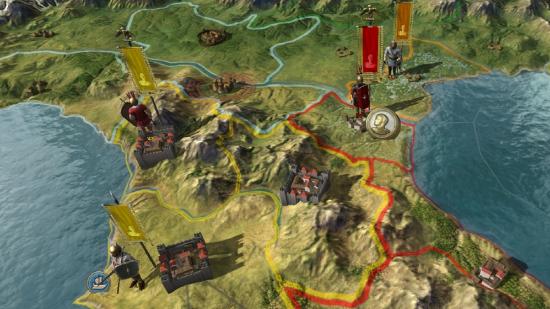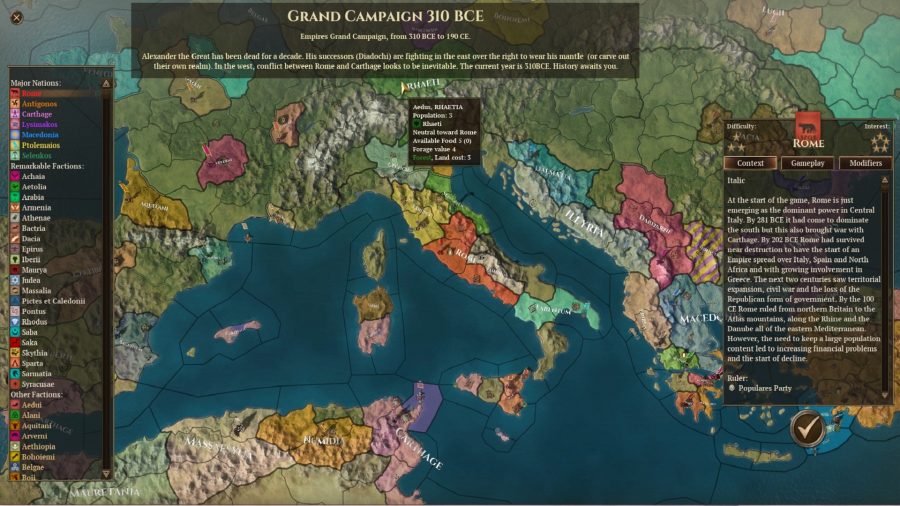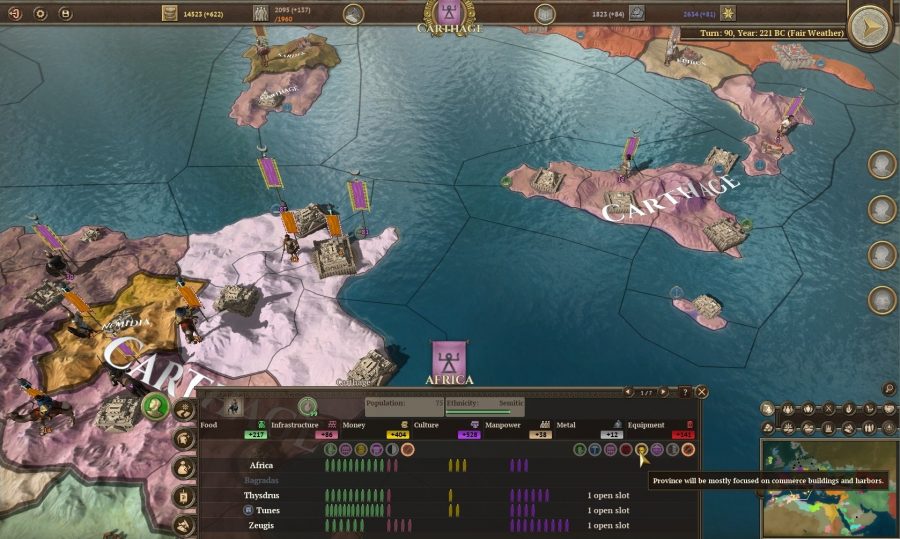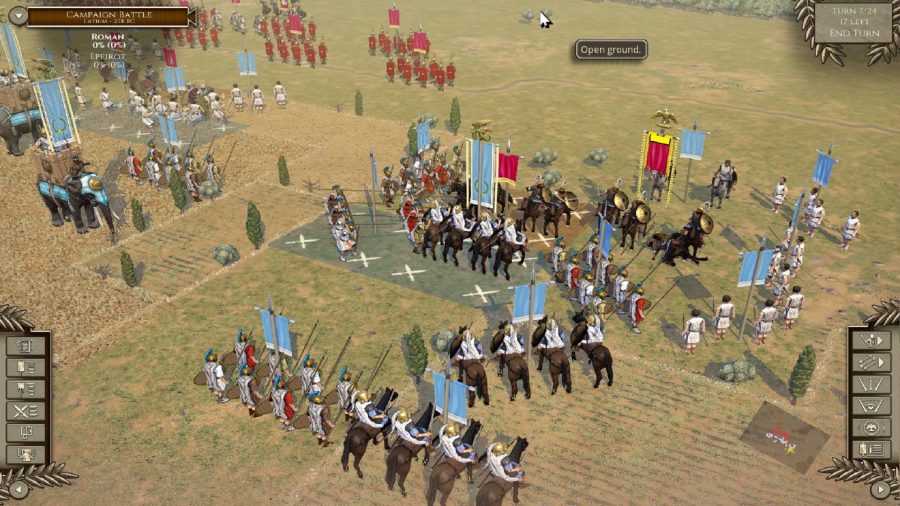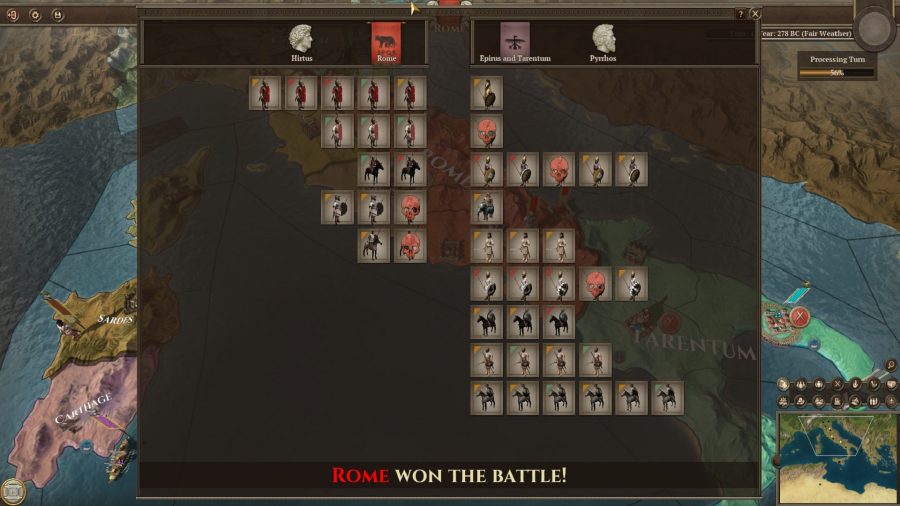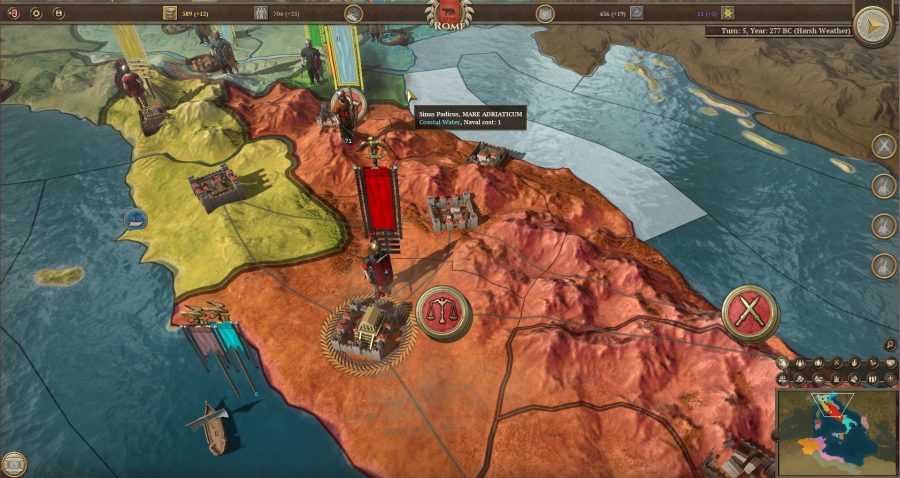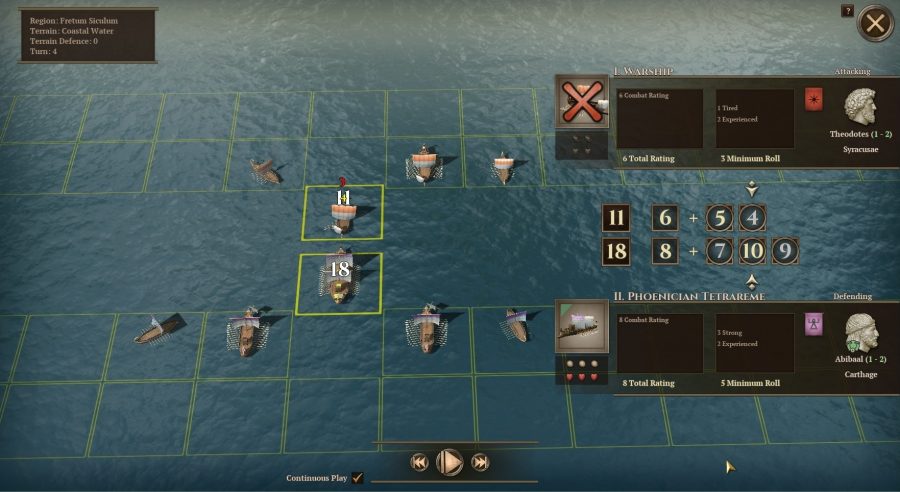BLUF – Bottom Line Up Front: They nailed it. Slitherine-AGEOD’s new grand strategy game Field of Glory: Empires is here, and I think it just set the standard on how challenging it was to be top dog in the days of Rome. I’m talking at least XII ‘Ave’s for not only producing one of the best ancient grand strategy games on the market, but because the designers have also taken the genre one step beyond. We’ve a lot to cover, so let’s begin.
Officially, Field of Glory: Empires (FOGE) is an area movement, grand strategy game where each turn represents a year and each military unit is about a legion’s worth of troops, some 5,000 men.
By grand strategy, I mean that you are the man in charge – Caesar, as it were – and your primary job in the game is supreme resource manager (plus). You have control over all the traditional stuff seen in such games such as agriculture, mining, trade, industry, the military, pretty much everything. To be successful, you must juggle all these commodities and more in order to pump up your military and expand your territory at the expense of other countries who decline to accept your benevolent rule. At the same time, your juggling act must also keep your people happy, prosperous and your political competition subdued.
It sounds like pretty normal stuff for a game like this, but don’t believe it and instead by all means download the free Player’s Guide, for there is much wisdom within its 214 pages. No, the book is not absolutely necessary to learn how to play the game, but it is really helpful to understand how your gameplay impacts the behind-the-screen calculations that determine whether you win or lose.
In effect, you win the game by the accumulation of Legacy Points, sorta the concept Brad Pitt talked about in the movie Troy concerning whether people would remember his name (Achilles, not Brad) after he died. Having a specific amount more than the second-place empire will win you the game automatically, while having more than anyone else at the end will do likewise. Legacy is a balance between your empire’s culture (points) which is positive, and decadence (points) which is negative. The latter is normally generated per region automatically but can increase or decrease based on a number of things such as political decisions, changing government types, construction beneficial to society or after pacifying newly conquered provinces..
Your decisions here will also impact your civilization levels, from I (as in Tribal Horde) through III (as in Empire), and the five sub-levels within each (Young, Stable, Glorious, Old and Decadent), plus the so-called ‘progress tokens’ they provide or deduct due to losing or completing objectives such as conquering a particular region and a host of other factors. In general, the higher your civilization level, the more decision-making authority you acquire and the more impact your decisions concerning resource management will have. And this, of course, feeds back into the legacy concept and round and round we go.
That’s a pretty simplistic overview, and I do have to wonder how much it will matter to the typical gamer. I do wonder whether most folks will simply ignore these issues and play the game as a pure military operation to see how much territory they can conquer most quickly. Seriously, you theoretically can win this game with legacy points even if your empire has collapsed.
That’s like winning at the Alamo because you lasted longer and inflicted more casualties than historically happened, even though in the end you were still wiped out.
However, because things like decadence will indirectly impact on how well you are able to do exactly that, this kind of ignorance can be dangerous. Its what makes a grand strategy game a grand strategy game and another VII ‘Ave’s to AGEOD for creating such an innovative system to replicate this, one that does not emphasize military prowess to the degree other games do.
Otherwise, the game looks and plays, at the grand-strategic level, pretty much the same way it did when I participated in the first FOGE playtesters’ challenge. The only cosmetic change immediately evident was that the province or region you’ve clicked on to manage now lightly pulsates its colour.
10 ’til 1066: The best ancients and medieval games
I originally thought it annoying, but after awhile I really liked it, as it quickly directed my attention where it currently needed to be. There are also a few other unique playing points that deserve a re-mention, not the least of which is the ability to move your population around to emphasize certain types of construction or infrastructure management, and to shuffle said population’s slave and citizen proportions to increase loyalty.
Likewise, if you conquer the correct, contiguous regions, you can combine them into a province which eases your administrative burden because you can treat this real estate as a single entity and slough policy implementation to the AI. On the military front, both size and force structure make a difference because there are now penalties if you march into a large region with too few troops, or not the correct mixture.
Which is a great segue into perhaps the most innovative part of the game. There is little doubt that a lot of hoopla over FOGE is due the ability to export battles into the tactical Field of Glory II (FOG2) computer game, fight the engagement out at the Cohort level, then import the results back into FOGE. So it was when I cranked up this latest edition to review I noticed two scenarios listed, one for the Grand Campaign (uh no, gotta sleep sometime) and one for a 15 turn, military oriented Pyrrhus scenario 281 BC.
Wanting to chuck a few pila as quickly as possible, I selected this option and chose to play as the fledging Roman Republic, taking a turn or two to build a few extra legions. I was curious as to how long I would wait to find someone to fight. Dumb question. On turn one, Pyrrhus and a 90-point Epirot army roared into one of the regions of province Italia Inferior, while a 28-point Tarentum army invaded a sister region. Next turn, new legions in hand, I marched to meet the Epirots, who immediately withdrew and of course I followed. The two factions ignored my army in Tarentum prime and instead circled back – and by game turn three I had all the Greek phalangists on the planet sitting outside Rome. The Senate was all a dither, but the city held until I could counter-march my legions back to confront Pyrrhus, and that’s when the magic began.
The window for the battle in Latium has a button that says Export Battle, and, when you click it, FOGE saves your turn and closes, bringing up the FOG2 splash screen. When you play, click on battles and, on the resulting screen, Empires Battles. This will take you to the imported battle, where you will be given a choice of redeploying your troops and adding an extra general on turn one (the first of 24). Accept this, and let the arrows loose.
For my battle, the terrain was not the generic, simplistic mish-mash you often get in other grand strategy games which purport to have an embedded tactical system. Instead, you get a drop-dead-gorgeous terrain table with lots of terrain, hobbit hovels and all. The armies themselves are the same expertly-rendered figures you find in FOG2, so in reality you are now playing a typical FOG2 game. Not.
Remember that manual I told you about? Read pages 135 – 140 on the battle system, and commit this sentence to memory, “In addition, it is worth noting that the game has been balanced around the battle system within Empires. So, in certain situations, it will be easier or harder to win if the battle is conducted in FOG2.” One of the things this might mean is that the units in the battle might look like the same units as in a standard FOG2 battle, but their underlying characteristics may well have changed.
Plumes and powderkegs: These are the best Napoleonic games
For example, Experience Points or upgrades from FOGE are likely to have been exported for units into FOG2. Likewise, there may well have been some substitutions since some FOGE units might not exist in FOG2 and vice versa. Combat results might also have changed.
At Latium, I’m betting Pyrrhus wishes he had some gold old fashioned A-10 Warthog or Typhoon FGR4 close air support, but since it wasn’t 1776, he had to suck it up and deal. And dealing with it meant facing Roman heavy infantry rated Elite (vice above average normally; I checked) with the Alae, those troops from Rome’s Italian allies, rated Superior. On impact, these lads were clocking up to 85 enemy casualties while receiving but 12 of their own.
Some Epirot and Tarentum units were Fractured and broke immediately, while conversely you could hit a Roman Triarii unit with everything but the proverbial kitchen basin for five turns straight and it would still trigger a “Held Firm” label. With this kind of bulldozer, manoeuvre was unnecessary as the Romans were able to plough straight thru the centre before either flank could be turned.
Thus, with eight turns left Rome was declared the victor, losing 30% of its own army while inflicting 63% casualties on the enemy. Returning to FOGE one saw the proud Roman soldier still on the field of battle, while what was left of Pyrrhus’ army had boarded ship for a long journey home.
I did notice that the AI led Epirot-Tarentum forced seemed abnormally docile and wouldn’t move a sandal until I advanced and forced the issue, Phalangists manoeuvred as independent units and light troops were a real pain. In the latter case, and Pyrrhus had a lot of these soldiers, the problem is that the battle is decided on how many units you rout, and light troops can pretty much Evade away from anything, as can heavy horse, something that took me by surprise. I was also just a little surprised that the size of the armies weren’t bigger given the number of points involved.
Regardless, the thing to remember is that in this game, the FOG2 battles are based on FOGE unit parameters, so they will not play the same as you are used to, even between armies you might have experience with.
FOGE is a revolutionary game, because its not just one game, and for this reason I wonder how well it will be received. Most gamers I know like to play battles or run countries, but not both. Thus while battle games like FOG2 or Sengoku Jidai do have campaign options, these are simplified activities designed for nothing else but generating tactical engagements. Strategic games do the same, except in reverse.
However, with FOGE and FOG2 you actually have a hybrid that works so smoothly together (and I saw not a hiccup once moving between the two) that in reality it has spawned a third completely different game.
Ship shape and Bristol fashion: The best naval games
And this new game, because of this strategic-tactical integration, is bound to produce a completely different type of gameplay because now, battles actually mean something to the bigger picture and they don’t work the way they used to.
Wow, I hope this concept is well received. Yes, this will make overall gameplay more time intensive since you are kicking in several extra hours to fight Latium and whatever comes after, but what a unique and challenging experience that will be. I heartily recommend you go for it, particularly since whatever this game costs, I’m betting a less expensive FOGE-FOG2 bundle is on the horizon.
Ave Maximus, AGEOD!
